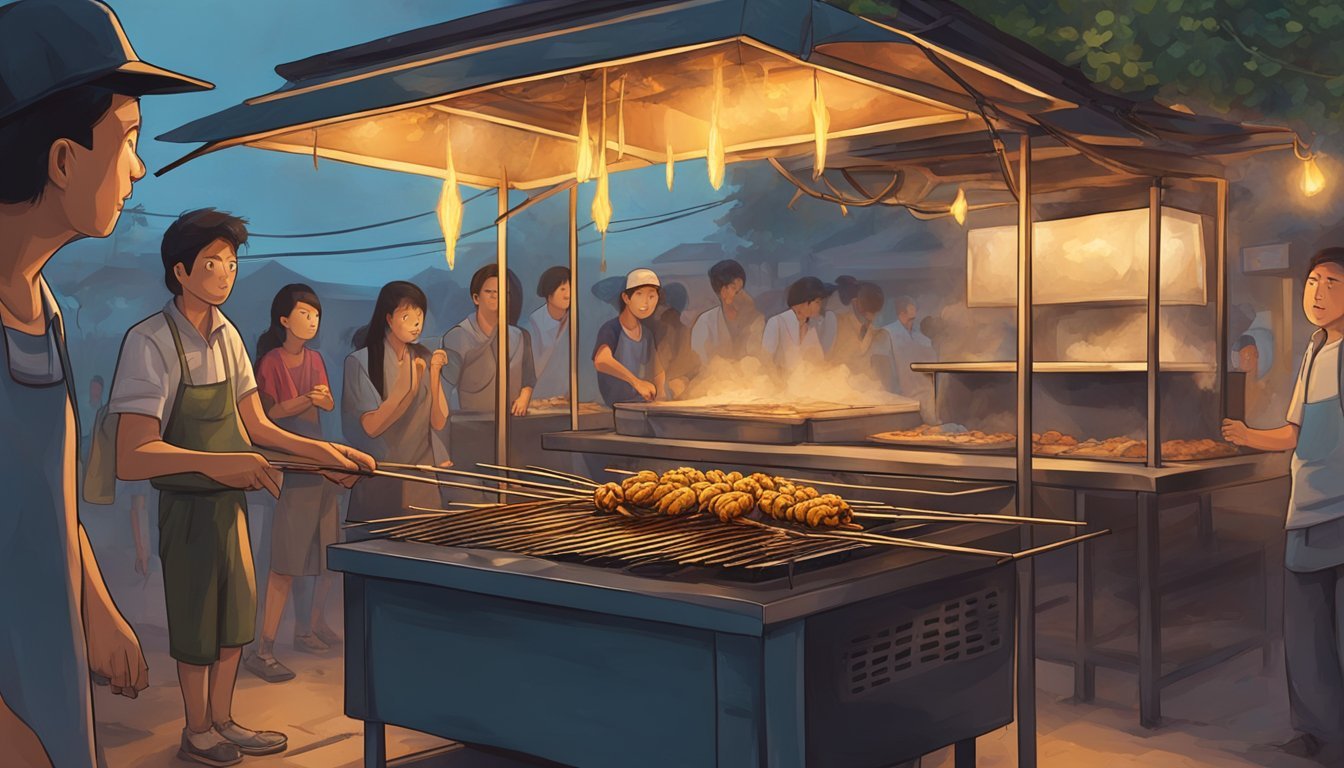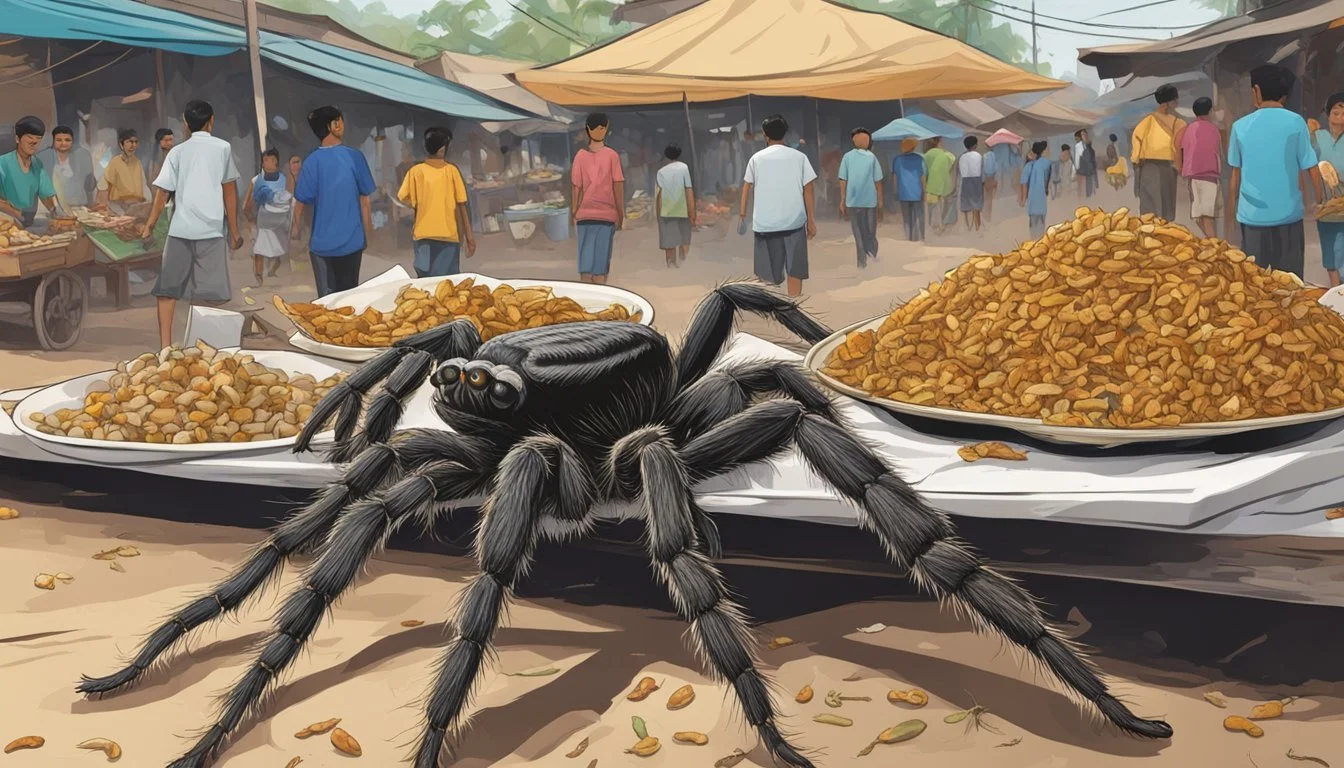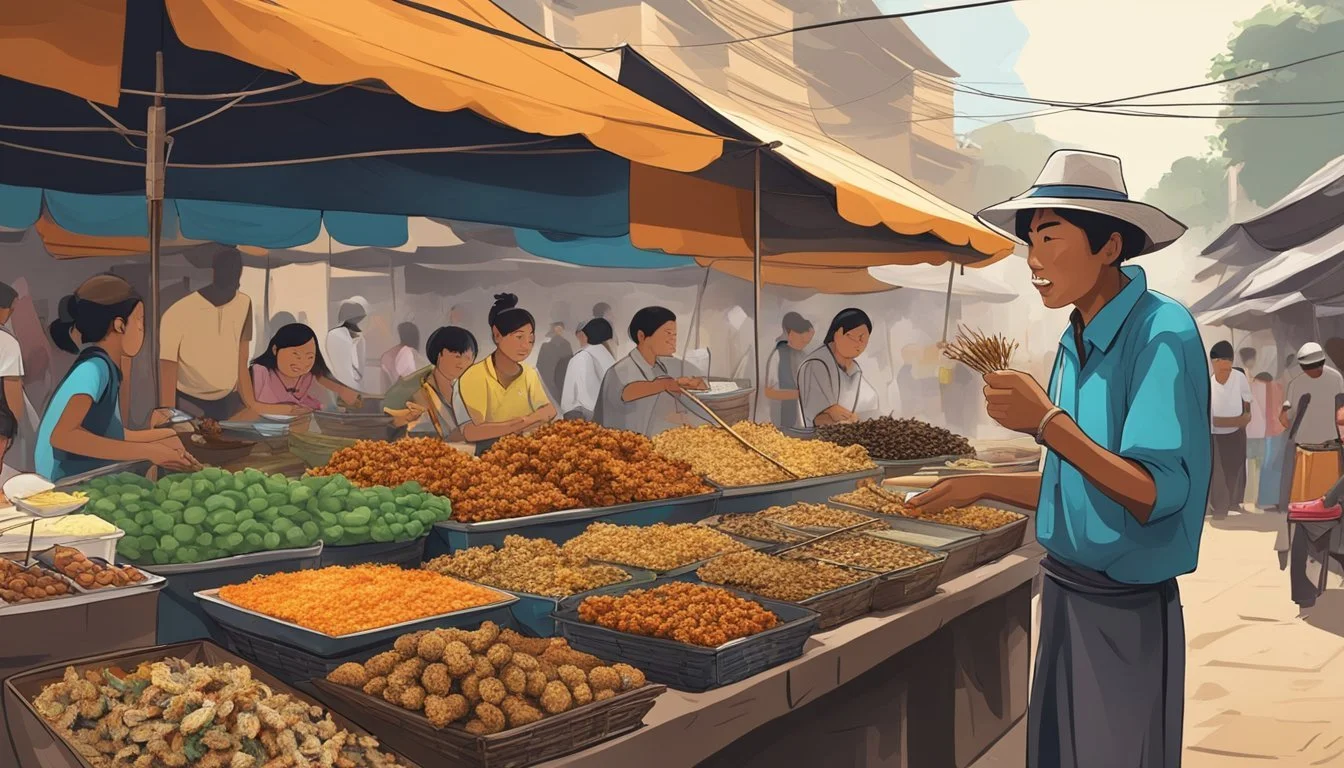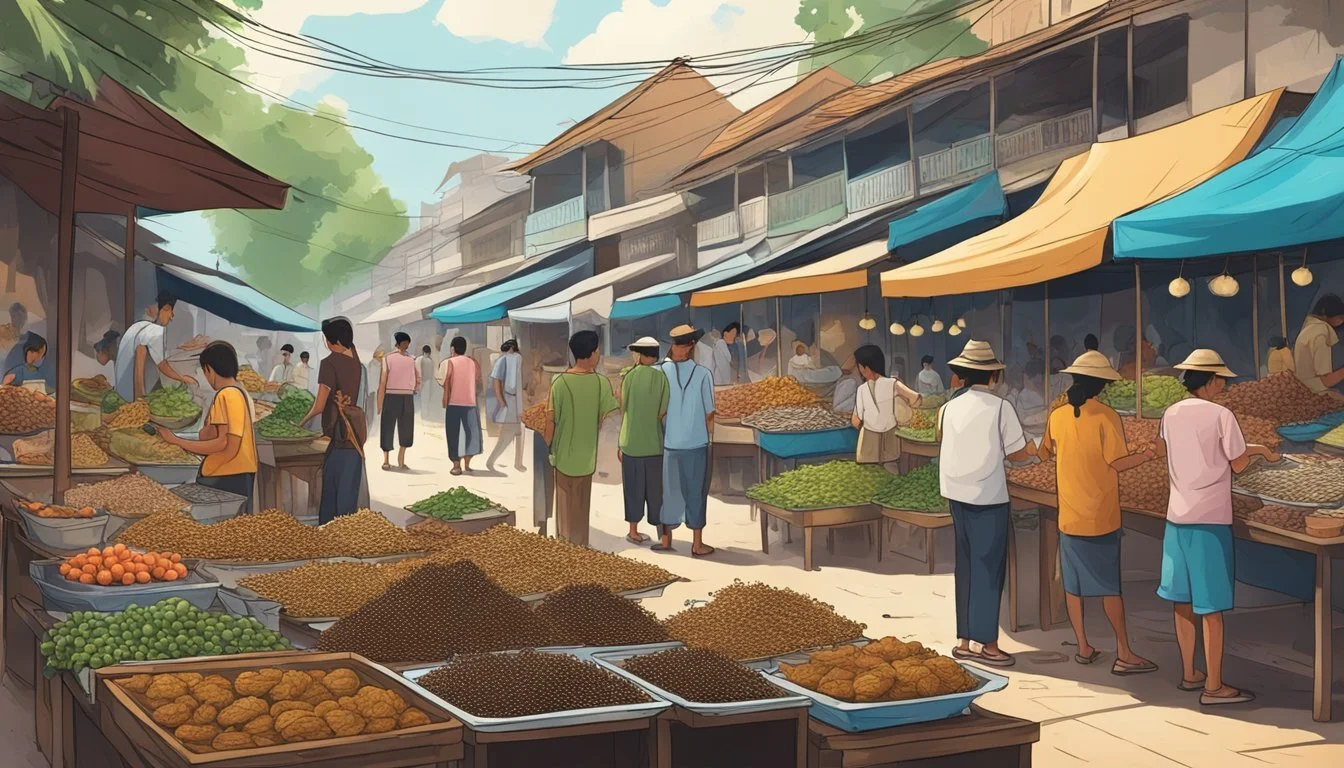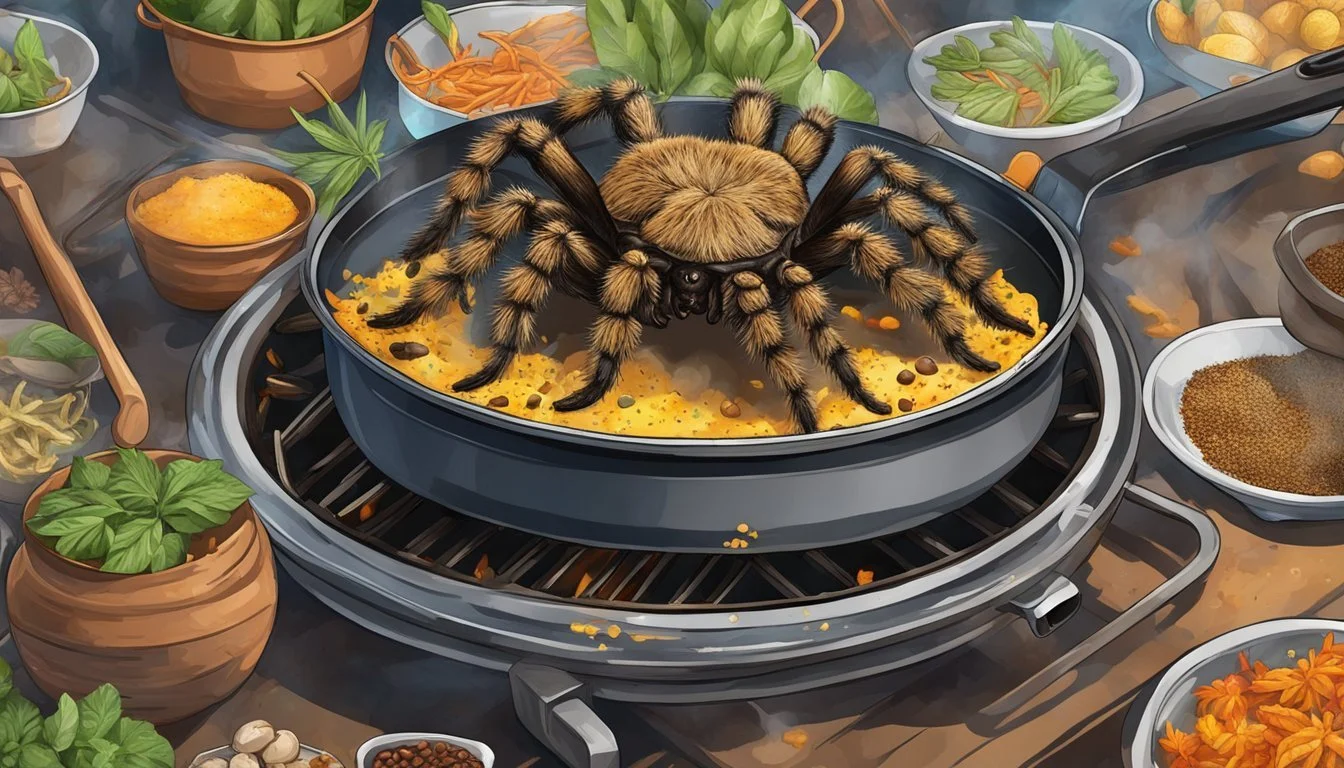Tarantula Unveiling Cambodia's Astonishing Delicacy Culture
In the bustling street food markets of Cambodia, adventurous eaters find a culinary experience that both enthralls and shocks the senses. Among these local delicacies is the tarantula, a dish with a history as rich as its flavor profile. These arachnids are not only a source of intrigue for tourists but also carry cultural and economic significance for the locals. Traditionally, these spiders were consumed out of necessity during times of famine, but today they have become a symbol of overcoming adversity and a testament to the resiliency of the Cambodian people.
Deep-fried tarantulas are now a popular street food in Cambodia, particularly in the town of Skuon, offering a crunchy and unique flavor that has been described as a cross between chicken and cod. Cooked with a marinade that typically includes sugar and garlic, this dish is a striking example of how traditional foods can be transformed into gourmet experiences. Despite their intimidating appearance, the local population values tarantulas for their supposed medicinal properties, further underpinning the spider's importance in Cambodian cuisine.
Handling and preparing these arachnids require specific expertise, ensuring that they are both palatable and safe for consumption. The preparation process adds to the spectacle as vendors deftly clean and cook the tarantulas in front of customers. Street food stands offering the fried spiders cater to both local connoisseurs and curious travelers, solidifying the tarantula's place in Cambodia's vibrant tapestry of street food offerings.
The Historical Context of Tarantulas as Food
The practice of eating tarantulas in Cambodia is deeply rooted in the nation's history, particularly as a response to the hardships faced during the Khmer Rouge regime. The tradition has since evolved, intertwining with cultural expression and economic considerations.
Khmer Rouge and Traditional Cambodian Cuisine
The Khmer Rouge took control of Cambodia on April 17, 1975. The regime's radical policies led to widespread famine and forced rural self-reliance. In these desolate times, Cambodians turned to unconventional food sources to survive. Tarantulas became a key part of the diet during this period. The arachnids were a source of protein in a time of severe starvation, marking a critical moment in Cambodia's culinary history.
Tarantulas in Cambodian Culture
Post-Khmer Rouge, tarantulas have retained their place in Cambodian culture as both a delicacy and a symbol of endurance. The frying of these arachnids is a culinary practice that honors past struggles while also serving the dual purposes of tourism attraction and income generation. Today, a large fried tarantula can fetch a significant price in Cambodian markets, reflecting both its popularity and its specialty status. Despite modernization, this tradition persists, with tarantulas firmly embedded in Cambodia's contemporary food scene.
Understanding Tarantulas
Tarantulas are among the larger species of spider and hold a significant spot in Cambodian culture and ecology. They are not just street food, but engaging creatures with distinct anatomy and habitats worth exploring.
Species and Habitat
Tarantulas belong to the family Theraphosidae and are found in various parts of the world, including Cambodia. These arachnids typically prefer forested environments, which provide them with shelter and prey. Habitat loss, primarily due to deforestation, poses a severe threat to their survival. As forests diminish, so do the natural homes of these spiders, challenging their existence.
Location: Tropical and subtropical regions
Shelter: Burrows, under rocks or tree barks
Climate: Warm and humid
Threats: Deforestation, Human Encroachment
Tarantula Anatomy
A tarantula's body is divided into two main parts: the cephalothorax (prosoma) and the abdomen (opisthosoma). The cephalothorax houses the eyes, mouthparts, and legs—eight in total, which are strong and adept for burrowing and capturing prey.
Here's a breakdown of the tarantula's anatomical features:
Cephalothorax: The front segment of the body which combines the head and the thorax; contains the central nervous system and the fangs.
Abdomen: Contains essential organs for digestion, reproduction, and silk production, often larger and more flexible than the cephalothorax.
A distinguishing feature of tarantulas is their setae, or hair-like structures, that cover their bodies. Some species can release these setae as a defense mechanism, causing irritation to potential predators or threats. This unique anatomy reflects the tarantula's adaptability and survival strategies within the forest ecosystem.
Tarantulas in the Cambodian Diet
In Cambodia, the consumption of tarantulas is not only a means to sustain tradition but also a form of nutrition. These arachnids, considered a delicacy, contribute an exotic touch to the local cuisine.
Nutritional Benefits
Tarantulas offer a good source of protein, with a single spider comprising significant amounts of this essential nutrient. In addition to protein, they contain vital minerals such as zinc, which is important for a healthy immune system, and folic acid, necessary for DNA synthesis and repair.
Protein: Helps in muscle building and repair
Zinc: Bolsters the immune system
Folic Acid: Crucial for cell growth and metabolism
Preparation and Cooking Methods
The preparation of a tarantula for consumption typically involves a thorough cleaning process followed by a marinade. Before being cooked, the tarantula is soaked in a mixture of sugar, salt, and light seasoning, sometimes with the inclusion of chicken powder. This process enhances the flavor and prepares the spider for frying.
Once marinated, the tarantula is deep-fried until it achieves a crispy texture. The fried tarantula's body becomes the centerpiece, with its legs often described as tasting similar to potato chips. Fried tarantulas are a common sight in Cambodian street food, with the creatures serving as both a delicacy and a delicious delimiter between standard street fare and adventurous eating.
Tarantula Hunting and Collection
In the dense forests of Cambodia, the practice of tarantula hunting secures both a source of income and a culinary delicacy. The methods employed by spider hunters are rooted in tradition, yet they raise concerns regarding the sustainability of tarantula populations.
Traditional Hunting Techniques
Tarantula hunters in Cambodia often rely on indigenous knowledge passed through generations. They embark on expeditions into the forests where specific techniques enable them to locate and capture these arachnids with remarkable efficiency.
Visual Inspection: Search for silk-lined burrows on the forest floor.
Manual Excavation: Use of sticks or hands to gently coax tarantulas from their hiding places.
Capture: Securing the tarantulas with minimal harm, often for live sale.
Tarantula hunting is typically conducted during the day as hunters scour areas near Siem Reap and the Skun spider market. They must be adept at identifying the subtle signs of tarantula habitation, such as silk strands around small holes or distinctive web patterns.
Impact of Over-Hunting
The rising demand for exotic foods and economic pressures have led to an intensification in tarantula hunting, causing concerns about over-hunting and its ecological consequences.
Ecosystem Balance: Tarantulas play a role in regulating insect populations and over-hunting can disrupt this balance.
Population Decline: Increased hunting pressures threaten tarantula populations, potentially leading to scarcity.
Conservation Efforts: Initiatives are required to educate hunters and the public on the importance of sustainable hunting practices to preserve both tradition and biodiversity.
While local families and spider hunters depend on this trade for their livelihood, the long-term effects of over-hunting may undermine both the species' survival and the continuation of this unique aspect of Cambodian culture.
Culinary Experience of Tarantula Consumption
The exotic delicacy of fried tarantula offers a unique blend of taste and texture, establishing itself as a mainstay in Cambodian street food culture.
Taste and Texture
The fried tarantula presents a complex flavor profile that is often compared to a crunchy texture reminiscent of a potato chip. The exterior is typically crisp, while the interior contrasts with a somewhat tender, almost cottony consistency. This can be likened to a textural delimiter, bridging the gap between the crunchy legs and the softer body. They are seasoned and often acquire a nuanced taste, infused with local spices which impart savory and sometimes slightly smoky notes.
The Role of Tarantula in Street Food
In the realm of Cambodian street food, the tarantula holds a significant spot. It is not just a form of sustenance but also a tourist attraction. It contributes to an immersive culinary experience for the adventurous eater. Street vendors typically serve them fried, aligning with local cooking traditions. The preparation method accentuates the tarantula's crunchy texture making it accessible and oddly familiar despite its exotic appearance.
Regional Significance
In Cambodia, the consumption of tarantulas as street food has both cultural and economic implications, with specific regions being key to its prominence.
Skuon: The Epicenter of Tarantula Cuisine
Skuon, often referred to as Spiderville, is a small town in Kampong Cham province that has become synonymous with tarantula cuisine. The markets of Skuon are renowned for their fried tarantulas, a practice said to have originated during the Khmer Rouge period. These arachnids are often paired with rice wine, serving as a unique gastronomic experience for both locals and visitors.
Location: Skuon, Kampong Cham province
Cuisine Highlight: Fried Tarantulas
Associated Beverage: Rice Wine
Spread to Urban Centers
From its origins in Skuon, tarantula consumption has spread to urban areas across Cambodia, including Siem Reap and Phnom Penh. In these bustling cities, tarantulas are sold in street markets, with vendors often establishing their stalls in areas frequented by tourists. This exotic dish has become an adventurous food experience that challenges cultural norms and culinary boundaries.
Key Urban Centers:
Siem Reap: A major tourist destination, where tarantula cuisine adds to the diverse food scene.
Phnom Penh: The capital city with street markets offering tarantulas as a testament to culinary daring.
In these regional hotspots, tarantulas continue to be a significant part of the street food culture, reflecting a tradition that has persevered and evolved over the years.
Conservation and Sustainability Concerns
The rising popularity of tarantulas as street food in Cambodia presents significant conservation and sustainability concerns, impacting both tarantula populations and their natural habitats.
Deforestation and Its Effects on Tarantula Populations
Deforestation, the major driver of habitat loss, poses a direct threat to tarantula species in Cambodia. The clearing of forests for agricultural expansion and the illegal timber industry reduces the natural environment that tarantulas depend on for survival. As these arachnids lose their habitats, their populations decline, disrupting the ecological balance.
Habitat Loss: With each acre of forest cleared, tarantulas are pushed further towards the brink. The loss of densely vegetated habitats directly limits their available hunting and breeding grounds.
Illegal Timber Industry: The illegal timber trade exacerbates the rate of deforestation, often escaping the effective control of authorities. Such activities not only decimate the tarantula's environment but also place additional pressure on Cambodia's delicate ecosystems.
Legal and Ethical Considerations
The harvesting of tarantulas for food and trade in Cambodia must navigate complex legal and ethical considerations. Internationally, trade regulations aim to curb the unsustainable exploitation of wildlife, including tarantulas.
Legal Framework: Trade in tarantula species is subject to national and international laws. Overharvesting for culinary purposes often tests the limits of these regulations.
Sustainability Efforts: Conservation bodies emphasize the need for sustainable practices to ensure the continued presence of tarantulas. Without these efforts, there's a risk that future generations might witness a marked decline or even the disappearance of these creatures.
Authorities in Cambodia are faced with the challenge of enforcing these legal parameters while addressing the socio-economic realities that propel the tarantula trade. Conservation groups and regulators are thus prompted to collaborate closely to find viable solutions that align the well-being of tarantula populations with local people's livelihoods.
Cultural Practices and Beliefs
In Cambodia, the practice of eating tarantulas is interwoven with cultural beliefs and knowledge passed down through generations. It embodies traditional medicine ideologies and highlights the continuity of indigenous knowledge.
Medicinal Uses of Tarantulas
Cambodian traditional medicine often incorporates a variety of natural resources, including fauna like tarantulas. People believe these arachnids can provide health benefits, such as alleviating back pain and bolstering energy levels. This use of tarantulas as a medicinal resource is typically informed by generational knowledge and is steeped in cultural history. However, it's important to note that the medicinal efficacy of tarantulas is not widely recognized by modern science.
Generational Knowledge Transfer
The utilization of tarantulas in Cambodian cuisine and medicine is a result of knowledge transfer across generations. Elders in communities share their understanding of tarantulas' preparation and perceived health benefits with younger members, ensuring this distinct aspect of Cambodian culture persists. This transfer extends not only to the techniques used to catch and cook tarantulas but also to the context and stories that accompany their use, making the practice a rich tapestry of shared cultural knowledge.
Economic Factors and Street Food Vendors
In Cambodia, particularly with tarantula vendors, economic factors play a crucial role in shaping the dynamics of local marketplaces. The presence of these vendors contributes to the financial landscape, providing insights into the interplay between tradition, sustenance, and income generation.
The Role of Tarantula Vending in Local Economy
Tarantula vendors have become a distinctive feature in Cambodian markets, selling a delicacy that fascinates tourists and sustains locals. Markets in Cambodia serve as critical junctions where these exotic treats fuel the economy. It is an activity handed down through generations, preserved more by economic necessity than culinary preference. For many locals, particularly in rural areas, tarantula vending yields an essential stream of income that may surpass minimum wage, providing relief from poverty.
Financial importance:
Attraction for tourists, potentially growing the local economy
Income source for families, sometimes pivotal for household survival
Financial Challenges and Opportunities
The economic landscape for tarantula vendors in Cambodia presents a complex tapestry of financial challenges and opportunities. Vendors face the reality of fluctuating demand, seasonal variations, and price sensitivity. Competition in the market can be fierce, and despite the popularity of tarantulas, securing a stable income can be a formidable challenge, especially for young girls who often help their families in vending operations. Yet, there is an undeniable entrepreneurial spirit, where vendors seize the opportunity to capitalize on a niche market, creating a unique economic delimiter that distinguishes them from other street food sellers.
Key financial elements:
Challenges: Market competition, income instability, and supply chain issues
Opportunities: Niche market exploitation, tourism linkage, and entrepreneurial growth
The Impact of Tourism on Tarantula Consumption
In Cambodia, the rising number of tourists has led to an increased demand for tarantulas as a unique snack, transforming local consumption patterns and how this traditional food is perceived.
Changing Attitudes Towards Eating Tarantulas
Initially, consuming tarantulas came out of necessity, especially during the food shortages in the 1970s under the Khmer Rouge regime. Nowadays, the presence of tourists has made eating tarantulas less about survival and more about novelty and culinary daring. This shift is evidenced by:
A significant increase in demand for tarantulas in tourist hotspots.
A gradual detachment of tarantula consumption from its roots in Cambodian culture and history.
Tarantulas as an Attraction for Tourists
Skewed from a survivalist's last resort to an exotic delicacy, tarantulas have become an attraction in themselves, changing the dynamics of the local food market. Key aspects of this change comprise:
Vendor Development: More stalls and restaurants centering tarantula dishes to entice tourists.
Cultural Shift: Locals now associate tarantulas with tourism revenue rather than traditional sustenance.
Media Exposure: Increased media coverage has contributed to the popularity of tarantulas as a 'must-try' experience for visitors.
The delimiter between survival food and tourist attraction blurs as Cambodia navigates the economic benefits and cultural shifts brought about by the global attention to one of its most shocking street foods.
Expanding Gastronomy
The culinary landscape of Cambodia is experiencing a transformative phase where traditional exotic treats like tarantulas are finding new roles in modern cuisine and gastronomic tourism.
Integration with Modern Cuisine
Innovative chefs across Cambodia have started to incorporate tarantulas into contemporary dishes, elevating their status from street food novelty to gourmet ingredient. Restaurants are experimenting with ways to blend the traditional flavors of tarantulas with modern culinary techniques. The use of spices and seasonings has become more refined, with chefs often opting for a balance of garlic and herbs as a delimiter to enhance the arachnid's natural taste without overpowering it.
Cooking Classes and Gastronomic Exploration
Cooking classes in Cambodia offer a hands-on experience to both locals and tourists eager to explore the country's culinary heritage. These classes often provide lessons on how to prepare tarantulas, teaching participants about the importance of specific seasonings and techniques for frying the spiders to achieve the desired flavor and texture. The sessions not only focus on tarantulas but also aim to immerse students in the rich tapestry of Cambodian cuisine, featuring a range of local herbs and spices.
Environmental and Legal Challenges
The consumption and trade of tarantulas in Cambodia not only sparks culinary curiosity but also raises significant environmental and legal issues, including habitat loss and the implications of wildlife trafficking legislation.
The Global Conversation on Wildlife Trade
The wildlife trade is a global concern with significant ecological implications. Cambodia, a participant in this trade through its market for tarantulas, is grappling with the balance between cultural practices and international standards on wildlife protection. The trade of tarantulas has garnered attention, prompting discussions about the legality and sustainability of such practices. With tarantula populations potentially at risk, there is growing pressure for authorities to intervene. International bodies are pushing for stricter regulations to prevent illegal wildlife trade, which often leads to habitat destruction and species endangerment.
Conservation Efforts in Cambodia
Conservation initiatives in Cambodia are becoming increasingly crucial to address habitat loss and deforestation. These environmental challenges directly impact the survival of many species, including tarantulas. Cambodian authorities are working to establish legal frameworks and conservation strategies to protect these creatures and their habitats. They enforce environmental laws and collaborate with local communities to manage and maintain sustainable ecosystems. This includes educational programs to raise awareness about the consequences of tarantula trade and consumption, as well as promoting alternative livelihoods to mitigate habitat destruction.
Progress in these areas is ongoing. The measures put forth by Cambodian lawmakers and conservationists are intricate parts of a broader attempt to safeguard the country's biodiversity and ensure the long-term viability of its unique species.
Conclusion
Fried tarantulas have transcended their origins as a means of survival to become a symbol of cultural resilience. The arachnids are deeply ingrained in Cambodian history, particularly as a source of sustenance during tumultuous times. Today, these creatures represent a link to the nation's past and a unique aspect of its present culinary landscape.
Tarantulas continue to hold a place of curiosity and intrigue among travelers, often finding themselves on the adventurous eater's bucket list. They are typically served fried, seasoned with a variety of flavors like sugar or garlic, and are sometimes hawked by street vendors or featured in restaurants. The consumption and sale of these spiders provide not only a unique gastronomic experience but also contribute to the local economy.
Fried Spider: Description - A Cambodian street food delicacy, Price Influence - Fetches a premium price, reflecting its rarity and demand.
In conclusion, the tarantula's journey from a survival food to a sought-after delicacy encapsulates the resilience and innovation of Cambodian cuisine. It is a dish that challenges palates and perceptions, inviting food connoisseurs and the curious to partake in a unique culinary tradition that tells a story of history, survival, and evolution.

